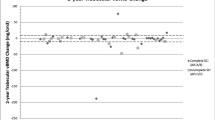Abstract
Introduction
The present case study compared bone density, bone geometry and muscle cross-sectional area (CSA) in a male who sustained spinal-cord injury (SCI) at birth (from here called SCI-B) with two matched controls without SCI, and also with four individuals with SCI of similar level and injury completeness but sustained at age 15 or greater.
Methods
All subjects with SCI were at least 3 years post-injury and had experienced motor incomplete lesions at the cervical level. Computed tomography was used to measure volumetric bone density, indices of bone strength [CSA and maximum, minimum and polar area moments of inertia (I max, I min, I pol)] and muscle CSA at the tibia (66% of tibia length, measured proximally from the distal end).
Results
Lower leg muscle CSA of SCI-B was 63±6% of values in non-SCI controls, and 72±12% of values in other males with SCI. In SCI-B, bone CSA was roughly half (52±4%) that of non-SCI controls and 73±16% of bone CSA values in other males with SCI. The magnitudes of the area moment of inertia variables (I max, I min, and I pol) in SCI-B were ~25% of control values. Further, the moment of inertia variables in SCI-B were 27–54% of values obtained in other males with SCI, indicating that experiencing SCI in the early stages of life has a remarkable impact on bone shape. Interestingly, tibia bone density did not appear to be affected; the average difference in bone density between SCI-B and non-SCI controls was −1.2±0.7%. The bone densities of other males with SCI were 4–19% lower than in SCI-B.
Conclusions
Muscle atrophy and bone loss are commonly reported consequences of SCI. This case reveals that important changes in bone geometry occur after SCI, and that mechanical loading during growth plays a vital role in the development of bone size and shape.
Similar content being viewed by others
References
Zehnder Y, Luthi M, Michel D, Knecht H, Perrelet R, Neto I, Kraenzlin M, Zach G, Lippuner K (2004) Long-term changes in bone metabolism, bone mineral density, quantitative ultrasound parameters, and fracture incidence after spinal cord injury: a cross-sectional observational study in 100 paraplegic men. Osteoporos Int 15(3):180–189
de Bruin ED, Herzog R, Rozendal RH, Michel D, Stussi E (2000) Estimation of geometric properties of cortical bone in spinal cord injury. Arch Phys Med Rehabil 81:150–156
Moynahan M, Betz RR, Triolo RJ, Maurer AH (1996) Characterization of the bone mineral density of children with spinal cord injury. J Spinal Cord Med 19(4):249–254
Martin RB (2002) Size, structure and gender: lessons about fracture risk. J Musculoskelet Neuronal Interact 2(3):209–211
Heinonen A, Sievanen H, Kannus P, Oja P, Vuori I (2002) Site-specific skeletal response to long-term weight training seems to be attributable to principal loading modality: a PQCT study of female weightlifters. Calcif Tissue Int 70(6):469–474
Jones HH, Priest JD, Hayes WC, Tichenor CC, Nagel DA (1977) Humeral hypertrophy in response to exercise. J Bone Jt Surg Am 59(2):204–208
Ditunno JF Jr, Young W, Donovan WH, Creasey G (1994) The international standards booklet for neurological and functional classification of spinal cord injury. American Spinal Injury Association. Paraplegia 32(2):70–80
Gluer CC, Blake G, Lu Y, Blunt BA, Jergas M, Genant HK (1995) Accurate assessment of precision errors: how to measure the reproducibility of bone densitometry techniques. Osteoporos Int 5(4):262–270
Lorentzon M, Mellstrom D, Ohlsson C (2005) Association of amount of physical activity with cortical bone size and trabecular volumetric BMD in young adult men: the GOOD study. J Bone Miner Res 20(11):1936–1943
Haapasalo H, Kontulainen S, Sievanen H, Kannus P, Jarvinen M, Vuori I (2000) Exercise-induced bone gain is due to enlargement in bone size without a change in volumetric bone density: a peripheral quantitative computed tomography study of the upper arms of male tennis players. Bone 27(3):351–357
Kontulainen S, Sievanen H, Kannus P, Pasanen M, Vuori I (2003) Effect of long-term impact-loading on mass, size, and estimated strength of humerus and radius of female racquet-sports players: a peripheral quantitative computed tomography study between young and old starters and controls. J Bone Miner Res 18(2):352–359
Eser P, Frotzler A, Zehnder Y, Wick L, Knecht H, Denoth J, Schiessl H (2004) Relationship between the duration of paralysis and bone structure: a PQCT study of spinal cord injured individuals. Bone 34(5):869–880
Castro MJ, Apple DF Jr, Hillegass EA, Dudley GA (1999) Influence of complete spinal cord injury on skeletal muscle cross-sectional area within the first 6 months of injury. Eur J Appl Physiol Occup Physiol 80(4):373–378
Castro MJ, Apple DF Jr, Hillegass EA, Dudley GA (1999) Influence of complete spinal cord injury on skeletal muscle cross-sectional area within the first 6 months of injury. Eur J Appl Physiol Occup Physiol 80(4):373–378
Author information
Authors and Affiliations
Corresponding author
Rights and permissions
About this article
Cite this article
Giangregorio, L.M., McCartney, N. Reduced loading due to spinal-cord injury at birth results in “slender” bones: a case study. Osteoporos Int 18, 117–120 (2007). https://doi.org/10.1007/s00198-006-0201-3
Received:
Accepted:
Published:
Issue Date:
DOI: https://doi.org/10.1007/s00198-006-0201-3




